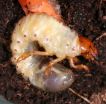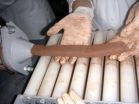(Press-News.org) Numerous geo-engineering schemes have been suggested as possible ways to reduce levels of the greenhouse gas carbon dioxide in the atmosphere and so reduce the risk of global warming and climate change. One such technology involves dispersing large quantities of iron salts in the oceans to fertilize otherwise barren parts of the sea and trigger the growth of algal blooms and other photosynthesizing marine life. Photosynthesis requires carbon dioxide as its feedstock and when the algae die they will sink to the bottom of the sea taking the locked in carbon with them.
Unfortunately, present plans for seeding the oceans with iron fail to take into account several factors that could scupper those plans, according to Daniel Harrison of the University of Sydney Institute of Marine Science, NSW. Writing in the International Journal of Global Warming, Harrison has calculated the impact of iron seeding schemes in terms of the efficiency of spreading the iron, the impact it will most likely have on algal growth the tonnage of carbon dioxide per square kilometer of ocean surface that will be actually absorbed compared to the hypothetical figures suggested by advocates of the approach.
"If society wishes to limit the contribution of anthropogenic carbon dioxide to global warming then the need to find economical methods of carbon dioxide sequestration is now urgent," Harrison's new calculations take into account not only the carbon dioxide that will be certainly be sequestered permanently to the deep ocean but also subtracts the many losses due to ventilation, nutrient stealing, greenhouse gas production and the carbon dioxide emitted by the burning of fossil fuels to produce the iron salts and to power their transportation and distribution at sea.
His calculations suggest that on average, a single ocean iron fertilization will result in a net sequestration of just 10 tonnes of carbon per square kilometer sequestered for a century or more at a cost of almost US$500 per tonne of carbon dioxide. "Previous estimates of cost fail to recognize the economic challenge of distributing low concentrations of iron over large areas of the ocean surface and the subsequent loss processes that result in only a small net storage of carbon per square kilometer fertilized," says Harrison.
Others have addressed the maximum possible contribution by modeling and the generally accepted figure is around 1 billion tonnes of carbon, but those calculations do not take into account the losses discussed by Harrison. The real limit would be when the macro-nutrients are exhausted, what then is the flux of macro-nutrients into the iron limited regions per year? "Under ideal conditions the cost could be lowered and the efficiency increased but the availability of ideal conditions will be small," says Harrison.
###"A method for estimating the cost to sequester carbon dioxide by delivering iron to the ocean" in Int. J. of Global Warming, 2013, in press
Geo-engineering against climate change
Seeding the oceans with iron may not address carbon emissions
2012-12-19
ELSE PRESS RELEASES FROM THIS DATE:
Better approach to treating deadly melanoma identified by scientists
2012-12-19
Scientists at The University of Manchester have identified a protein that appears to hold the key to creating more effective drug treatments for melanoma, one of the deadliest cancers.
Researchers funded by Cancer Research UK have been looking at why new drugs called "MEK inhibitors", which are currently being tested in clinical trials, aren't as effective at killing cancer cells as they should be.
They discovered that MITF - a protein that helps cells to produce pigment but also helps melanoma cells to grow and survive - is able to provide cancer cells with a resistance ...
Fast-acting enzymes with 2 fingers: Protein structurally and dynamically explained
2012-12-19
Researchers at the RUB and from the MPI Dortmund have uncovered the mechanism that
switches off the cell transport regulating proteins. They were able to resolve in detail how the central switch protein Rab is down-regulated with two "protein fingers" by its interaction partners. The structural and dynamic data is reported by the researchers led by Prof. Dr. Klaus Gerwert (Chair of Biophysics, RUB) and Prof. Dr. Roger S. Goody (Max Planck Institute for Molecular Physiology, Dortmund, Germany) in the Online Early Edition of the journal PNAS. "Unlike in the cell growth protein ...
Badger sleeping habits could help target TB control
2012-12-19
Scientists found that badgers which strayed away from the family burrow in favour of sleeping in outlying dens were more likely to carry TB.
The 12-month study of 40 wild badgers was funded by the Department for Environment, Food and Rural Affairs (Defra) and could have implications for the management of bovine TB in parts of the UK. The behaviour of individual animals is thought to be a key factor in how the disease is spread among animals and livestock. The new findings could help to understand and develop measures to manage TB in badgers.
The study is published ...
The role of the innate immune cells in the development of type 1 diabetes
2012-12-19
The researchers reveal the role of the innate immune cells, especially the dendritic cells, that cause the activation of the killer T-lymphocytes whose action is directed against the p pancreatic cells. The results obtained in mice make it possible to consider new ways of regulating the auto-immune reaction generated by the innate immune cells.
Type 1 diabetes, or insulin-dependent diabetes, is an auto-immune disease characterised by the destruction of insulin-producing pancreatic β cells that are present in the Islets of Langerhans which are themselves in the pancreas. ...
Not without my microbes
2012-12-19
Apart from the common European cockchafer (Melolontha melolontha), the European forest cockchafer (Melolontha hippocastani) is the most common species of the Melolontha genus. These insects can damage huge areas of broadleaf trees and conifers in woodlands and on heaths. Cockchafers house microbes in their guts that help them to digest their woody food, such as lignocelluloses and xylans. Scientists of the Max Planck Institute for Chemical Ecology in Jena, Germany, have now performed comprehensive RNA analyses and identified the microbiota of cockchafer larvae feeding on ...
Scale-up of a temporary bioartificial liver support system described in BioResearch Open Access
2012-12-19
New Rochelle, NY, December 19, 2012—Acute liver failure is usually fatal without a liver transplant, but the liver can regenerate and recover if given time to heal. A bioartificial liver machine that can provide temporary support while organ regeneration takes place has been scaled up for testing in a large animal model and is described in an article in BioResearch Open Access, a bimonthly peer-reviewed open access journal from Mary Ann Liebert, Inc., publishers. The article is available on the BioResearch Open Access website .
A team of researchers from University College ...
When the ice melts, the Earth spews fire
2012-12-19
In 1991, it was a disaster for the villages nearby the erupting Philippine volcano Pinatubo. But the effects were felt even as far away as Europe. The volcano threw up many tons of ash and other particles into the atmosphere causing less sunlight than usual to reach the Earth's surface. For the first few years after the eruption, global temperatures dropped by half a degree. In general, volcanic eruptions can have a strong short-term impact on climate. Conversely, the idea that climate may also affect volcanic eruptions on a global scale and over long periods of time is ...
Paper waste used to make bricks
2012-12-19
Researchers at the University of Jaen (Spain) have mixed waste from the paper industry with ceramic material used in the construction industry. The result is a brick that has low thermal conductivity meaning it acts as a good insulator. However, its mechanical resistance still requires improvement.
"The use of paper industry waste could bring about economic and environmental benefits as it means that material considered as waste can be reused as raw material." – This is one of the conclusions of the study developed by researchers at the Upper Polytechnic School of Linares ...
New dynamic dual-core optical fiber enhances data routes on information superhighway
2012-12-19
Optical fibers –the backbone of the Internet–carry movies, messages, and music at the speed of light. But for all their efficiency, these ultrathin strands of pristine glass must connect to sluggish signal switches, routers, and buffers in order to transmit data. Hoping to do away with these information speed bumps, researchers have developed a new, dual-core optical fiber that can perform the same functions just by applying a miniscule amount of mechanical pressure.
These new nanomechanical fibers, which have their light-carrying cores suspended less than 1 micrometer ...
Cholesterol helps regulate key signaling proteins in the cell
2012-12-19
Cholesterol plays a key role in regulating proteins involved in cell signaling and may be important to many other cell processes, an international team of researchers has found.
The results of their study are reported in the journal Nature Communications.
Cholesterol's role in heart disease has given it a bad reputation. But inside the thin membrane of a cell, the tight regulation of cholesterol at high levels (30 to 40 percent) suggests that it plays an important role in cellular processes, says Wonhwa Cho, professor of chemistry at the University of Illinois at Chicago ...
LAST 30 PRESS RELEASES:
What causes some people’s gut microbes to produce high alcohol levels?
Global study reveals widespread burning of plastic for heating and cooking
MIT study shows pills that communicate from the stomach could improve medication adherence
Searching for the centromere: diversity in pathways key for cell division
Behind nature’s blueprints
Researchers search for why some people’s gut microbes produce high alcohol levels
Researchers find promising new way to boost the immune response to cancer
Coffee as a staining agent substitute in electron microscopy
Revealing the diversity of olfactory receptors in hagfish and its implications for early vertebrate evolution
Development of an ultrasonic sensor capable of cuffless, non-invasive blood pressure measurement
Longer treatment with medications for opioid use disorder is associated with greater probability of survival
Strategy over morality can help conservation campaigns reduce ivory demand, research shows
Rising temperatures reshape microbial carbon cycling during animal carcass decomposition in water
Achieving ultra-low-power explosive jumps via locust bio-hybrid muscle actuators
Plant-derived phenolic acids revive the power of tetracycline against drug-resistant bacteria
Cooperation: A costly affair in bacterial social behaviour?
Viruses in wastewater: Silent drivers of pollution removal and antibiotic resistance
Sub-iethal water disinfection may accelerate the spread of antibiotic resistance
Three in four new Australian moms struggle with body image
Post-stroke injection protects the brain in preclinical study
Cardiovascular risk score predicts multiple eye diseases
Health: estimated one in ten British adults used or interested in GLP-1 medications for weight loss
Exercise to treat depression yields similar results to therapy
Whooping cough vaccination for pregnant women strengthens babies’ immune system
Dramatic decline in new cases of orphanhood in Uganda driven by HIV treatment and prevention programs
Stopping weight loss drugs linked to weight regain and reversal of heart health markers
Higher intake of food preservatives linked to increased cancer risk
Mass General Brigham–developed cholera vaccine completes phase 1 trial
First experimental validation of a “150-year-old chemical common sense” direct visualization of the molecular structural changes in the ultrafast anthracene [4+4] photocycloaddition reaction
Lack of support for people on weight loss drugs leaves them vulnerable to nutritional deficiencies, say experts
[Press-News.org] Geo-engineering against climate changeSeeding the oceans with iron may not address carbon emissions



